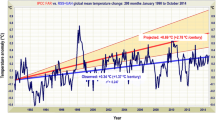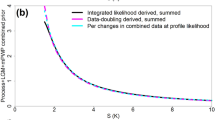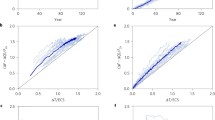Abstract
Monckton of Brenchley et al. (Sci Bull 60:122–135, 2015) (hereafter called M15) use a simple energy balance model to estimate climate response. They select parameters for this model based on semantic arguments, leading to different results from those obtained in physics-based studies. M15 did not validate their model against observations, but instead created synthetic test data based on subjective assumptions. We show that M15 systematically underestimate warming: since 1990, most years were warmer than their modelled upper limit. During 2000–2010, RMS error and bias are approximately 150 % and 350 % larger than for the CMIP5 median, using either the Berkeley Earth or Cowtan and Way surface temperature data. We show that this poor performance can be explained by a logical flaw in the parameter selection and that selected parameters contradict observational estimates. M15 also conclude that climate has a near-instantaneous response to forcing, implying no net energy imbalance for the Earth. This contributes to their low estimates of future warming and is falsified by Argo float measurements that show continued ocean heating and therefore a sustained energy imbalance. M15’s estimates of climate response and future global warming are not consistent with measurements and so cannot be considered credible.

Similar content being viewed by others
References
Monckton of Brenchley C, Soon WW-H, Legates DR et al (2015) Why models run hot: results from an irreducibly simple climate model. Sci Bull 60:122–135
IPCC AR5 (2013) Climate change 2013: the physical science basis. In: Stocker TF, Qin D, Plattner G-K et al (eds) Contribution of working group I to the fifth assessment report of the intergovernmental panel on climate change. Cambridge University Press, Cambridge
Sellers WD (1969) A global climatic model based on the energy balance of the Earth-atmosphere system. J App Met 8:392–400
Otto A, Otto FE, Boucher O et al (2013) Energy budget constraints on climate response. Nat Geosci 6:415–416
Lewis N, Curry JA (2014) The implications for climate sensitivity of AR5 forcing and heat uptake estimates. Clim Dyn 1–15
Roe G (2009) Feedbacks, timescales, and seeing red. Ann Rev Earth Planet Sci 37:93–115
Hoffert M, Callegari AJ, Ching-Tzong H (1980) The role of deep sea heat storage in the secular response to climatic forcing. J Geophys Res 85:6667–6679
Geoffroy O, Saint-Martin D, Olivie DJL et al (2013) Transient climate response in a two-layer energy-balance model. Part I: analytical solution and parameter calibration using CMIP5 AOGCM experiments. J Clim 26:1841–1857
Geoffroy O, Saint-Martin D, Voldoire A et al (2013) Transient climate response in a two-layer energy-balance model. Part II: representation of the efficacy of deep-ocean heat uptake and validation for CMIP5 AOGCMs. J Clim 26:1826–1876
Held IM, Winton M, Takahasi K et al (2010) Probing the fast and slow components of global warming by returning abruptly to pre-industrial forcing. J Clim 23:2418–2427
Murphy DM, Solomon S, Portmann RW et al (2009) An observationally based energy balance for the Earth since 1950. J Geophys Res 114:D17107
Rose BEJ, Armour KC, Battisti DS et al (2014) The dependence of transient climate sensitivity and radiative feedbacks on the spatial pattern of ocean heat uptake. Geophys Res Lett 41:1071–1078
Armour KC, Bitz CM, Roe GH (2013) Time-varying sensitivity from regional feedbacks. J Clim 26:4518–4534
Yoshimori M, Hargreaves JC, Annan JD et al (2011) Dependency of feedbacks on forcing and climate state in physics parameter ensembles. J Clim 24:6440–6455
Foster G, Rahmstorf S (2011) Global temperature evolution 1979–2010. Environ Res Lett 6:044022
Meinhausen M, Smith SJ, Calvin K et al (2011) The RCP greenhouse gas concentrations and their extensions from 1765 to 2300. Clim Change 109:213–241
Koninklijk Nederlands Meteorologisch Instituut (2015) http://knmi.nl/. Accessed Feb 2015
Cowtan K, Way RG (2014) Coverage bias in the HadCRUT4 temperature series and its impact on recent temperature trends. Q J R Meteorol Soc 140:1935–1944
Petit JR, Jouzel J, Raynaud D et al (1999) Climate and atmospheric history of the past 420,000 years from the Vostok ice core, Antarctica. Nature 399:429–436
Jouzel J, Masson-Delmotte V, Cattani O et al (2007) Orbital and millennial Antarctic climate variability over the past 800,000 years. Science 317:793–796
Zachlos JC, Shackleton NJK, Revenaugh NJ et al (2001) Climate response to orbital forcing across the Oligocene-Miocene boundary. Science 292:274–277
Hargreaves JC, Abe-Ouchi A, Annan JD (2007) Linking glacial and future climates through an ensemble of GCM simulations. Clim Past 3:77–87
Lorius C, Jouzel J, Raynaud D et al (1990) The ice-core record—climate sensitivity and future greenhouse warming. Nature 347:139–145
Hoffert MI, Covey C (1992) Deriving global climate sensitivity from palaeoclimate reconstructions. Nature 360:573–576
Covey C, Sloan LC, Hoffert MI (1996) Paleoclimate data constraints on climate sensitivity: the paleocalibration method. Clim Change 32:165–184
Annan JD, Hargreaves JC, Ohgaito R et al (2005) Efficiently constraining climate sensitivity with ensembles of paleoclimate simulations. SOLA 1:181–184
Masson-Delmotte V, Kageyama M, Braconnot P et al (2006) Past and future polar amplification of climate change: climate model intercomparisons and ice-core constraints. Clim Dyn 26:513–529
Crucifix M (2006) Does the Last Glacial Maximum constrain climate sensitivity? Geophys Res Lett 33:L18701
Knutti R, Hegerl GC (2008) The equilibrium sensitivity of the Earth’s temperature to radiation changes. Nat Geosci 1:735–743
Loeb NG, Lyman KM, Johnson JC et al (2012) Observed changes in top-of-the-atmosphere radiation and upper-ocean heating consistent within uncertainty. Nat Geosci 5:110–113
Abraham JP, Baringer M, Bindoff NL et al (2013) A review of global ocean temperature observations: implications for ocean heat content estimates and climate change. Rev Geophys 51:450–483
Watterson IG (2000) Interpretation of simulated global warming using a simple model. J Clim 21:5624–5628
Gregory JM (2000) Vertical heat transports in the ocean and their effect on time-dependent climate model integrations. J Clim 19:6181–6194
Schwartz SE (2007) Heat capacity, time constant, and sensitivity of Earth’s climate system. J Geophys Res 112:paper D24S05
Murphy DM, Forster PM (2010) On the accuracy of deriving climate feedback parameters from correlations between surface temperatures and outgoing radiation. J Clim 23:4983–4988
Gorman JM, Abraham JP, Sparrow EM (2014) A novel, comprehensive numerical simulation for predicting temperatures within boreholes and the adjoining rock bed. Geothermics 50:213–219
Personal communication, Gerard Roe, February 17, 2015
Schmidt GA, Shindell DT, Tsigaridis K (2014) Reconciling warming trends. Nat Geosci 7:158–160
Santer BD, Bonfils C, Painter JF et al (2014) Volcanic contribution to decadal changes in tropospheric temperature. Nat Geosci 7:185–189
Solomon S, Rosenlof KH, Portmann RW et al (2010) Contributions of stratospheric water vapor to decadal changes in the rate of global warming. Science 327:1219–1223
Trenberth KE, Fasullo JT, Branstator G et al (2014) Seasonal aspects of the recent pause in surface warming. Nat Clim Change 4:911–916
Abraham JP, Fasullo JT, Laden G (2014) Continued global warming in the midst of natural climate fluctuations. Rep Natl Center Sci Educ 34:2.1–2.9
Kosaka Y (2014) Increasing wind sinks heat. Nat Geosci 4:172–173
England MH, McGregor S, Spence P et al (2014) Recent intensification of wind-driven circulation in the Pacific and the ongoing warming hiatus. Nat Geosci 4:222–227
IPCC FAR (1990) Climate change—the IPCC assessment. In: Houghton JT, Jenkins GJ, Ephraums JJ (eds) Report prepared for the intergovernmental panel on climate change by working group I. Cambridge University Press, Cambridge, NY
Hansen J, Fung I, Lacis A et al (1988) Global climate changes as forecast by Goddard Institute for Space Studies three-dimensional model. J Geophys Res Atmos 93(D8):9341–9364
IPCC AR4 (2007) Climate change 2007: the physical science basis. In: Solomon S, Qin D, Manning M et al (eds) Contribution of the working group I to the fourth assessment report of the intergovernmental panel on climate change, 2007. Cambridge University Press, Cambridge, NY
Soden BJ, Held IM (2006) An assessment of climate feedbacks in coupled ocean-atmosphere models. J Clim 19:3354–3360
Vial J, Dufresne J-L, Bony S (2013) On the interpretation of inter-model spread in CMIP5 climate sensitivity estimates. Clim Dyn 41:3339–3362
Gregory JM, Ingram WJ, Palmer MA et al (2004) A new method for diagnosing radiative forcing and climate sensitivity. Geophys Res Lett 31:L03205
Spencer RW, Braswell WD (2011) On the misdiagnosis of surface temperature feedbacks from variations in Earth’s radiant-energy balance. Remote Sens 3:1603–1613
Trenberth KE, Fasullo JT, Abraham JP (2011) Issues in establishing climate sensitivity in recent studies. Remote Sens 3:2051–2055
Dessler AE (2011) Cloud variations and the Earth’s energy budget. Geophys Res Lett 38:L19701
Lindzen RS, Choi Y-S (2011) On the observational determination of climate sensitivity and its implications. Asia-Pac J Atmos Sci 47:377–390
Lindzen RS, Choi Y-S (2009) On the determination of climate feedbacks from ERBE data. Geophys Res Lett 36:L16705
Murphy DM (2010) Constraining climate sensitivity with linear fits to outgoing radiation. Geophys Res Lett 37:L09704
Trenberth KE, Fasullo JT, O’Dell C et al (2010) Relationships between tropical sea surface temperature and top-of-atmosphere radiation. Geophys Res Lett 37:L03702
Chung E-S, Soden BJ, Sohn B-J (2010) Revisiting the determination of climate sensitivity from relationships between surface temperature and radiative fluxes. Geophys Res Lett 37:L10703
Dessler AE (2010) A determination of the cloud feedback from climate variations over the last decade. Science 330:1523–1527
Dessler AE (2013) Observations of climate feedbacks over 2000–2010 and comparisons with climate models. J Clim 26:33–342
RSS (2014) Satellite-derived monthly global mean lower-troposphere temperature anomaly dataset: www.remss.com/data/msu/monthly_time_series/RSS_Monthly_MSU_AMSU_Channel_TLT_Anomalies_Land_and_Ocean_v03_3.txt. Accessed Feb 2015
University of Alabama at Huntsville (UAH) (2014) Satellite MSU monthly global mean lower-troposphere temperature anomalies. http://vortex.nsstc.uah.edu/data/msu/t2lt/uahncdc_lt_5.6.txt. Accessed Feb 2015
Abraham JP, Cook J, Fasullo JT et al (2014) Review of the consensus and asymmetric quality of research on human-induced climate change. Cosmopolis 2014–1:3–18
Hansen JE, Wilson H (1993) Commentary on the significance of global temperature records. Clim Change 25:896–910
Schneider SH (1994) Detecting climatic change signals: are there any “fingerprints”? Science 263:341–347
Hurrell JW, Trenberth KE (1997) Spurious trends in satellite MSU temperatures from merging different satellite records. Nature 386:164–167
Hurrell JW, Trenberth KE (1998) Difficulties in obtaining reliable temperature trends: reconciling the surface and satellite microwave sounding unit records. J Clim 11:945–967
Wentz FJ, Schabel MC (1998) Effects of orbital decay on satellite-derived lower tropospheric temperature trends. Nature 394:661–664
Mears CA, Schabel MC, Wentz FJ (2003) A reanalysis of the MSU channel 2 tropospheric temperature record. J Clim 16:3650–3664
Mears CA, Wentz FJ (2005) The effect of diurnal correction of satellite-derived lower tropospheric temperature. Science 309:1548–1551
Sherwood SC, Lanzante JR, Meyer CL (2005) Radiosonde daytime biases and late-20th century warming. Science 309:1556–1559
Randel WJ, Wu F (2006) Biases in stratospheric and tropospheric temperature trends derived from historical radiosonde data. J Clim 19:2094–2104
Thorne PW, Parker DE, Tett SFB et al (2005) Revisiting radiosonde upper air temperatures from 1958 to 2002. J Geophys Res 110:D18105
Lanzante JR, Free M (2008) Comparison of radiosonde and GCM vertical temperature trend profiles: effects of dataset choice and data homogenization. J Clim 21:5417–5435
Allen RJ, Sherwood SC (2008) Warming maximum in the tropical upper troposphere deduced from thermal winds. Nat Geosci 1:399–403
Santer BD, Thorne PW, Haimberger L et al (2008) Consistency of modelled and observed temperature trends in the tropical troposphere. Int J Climatol 28:1703–1722
Titchner HA, Thorne PW, McCarthy MP (2009) Critically assessing tropospheric temperature trends from radiosondes using realistic validation experiments. J Clim 22:465–485
Thorne PW, Lanzante JR, Peterson TC et al (2011) Tropospheric temperature trends: history of an ongoing controversy. Clim Change 2:66–88
Po-Chedley S, Fu Q (2012) A bias in the mid-tropospheric channel warm target factor on the NOAA-9 microwave sounding unit. J Atmos Ocean Tech 29:646–652
Weng F, Zou X, Qin Z (2014) Uncertainty of AMSU-A derived temperature trends in relationship with clouds and precipitation over ocean. Clim Dyn 43:1439–1448
Po-Chedley S, Thorsen TJ, Fu Q (2015) Removing diurnal cycle contamination in satellite-derived tropospheric temperatures: understanding tropical tropospheric trend discrepancies. J Clim 28:2274–2290
Marotzke J, Forster PM (2015) Forcing, feedback and internal variability in global temperature trends. Nature 517:565–570
Conflict of interest
The authors declare that they have no conflict of interest.
Author information
Authors and Affiliations
Corresponding author
About this article
Cite this article
Richardson, M., Hausfather, Z., Nuccitelli, D.A. et al. Misdiagnosis of Earth climate sensitivity based on energy balance model results. Sci. Bull. 60, 1370–1377 (2015). https://doi.org/10.1007/s11434-015-0806-z
Received:
Accepted:
Published:
Issue Date:
DOI: https://doi.org/10.1007/s11434-015-0806-z




